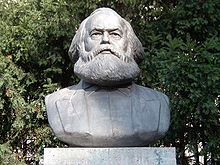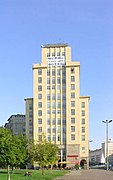Strausberger Platz
|
|
|
|---|---|
| Place in Berlin | |
 The square seen to the west |
|
| Basic data | |
| place | Berlin |
| District | Friedrichshain |
| Created | 1967 |
| Confluent streets |
Lichtenberger Strasse , Karl-Marx-Allee |
| Buildings | House Berlin |
| use | |
| User groups | Pedestrians , cyclists , car traffic , public transport |
| Space design | Hermann Henselmann |
The Strausbergerplatz is a large urban square in Berlin district of Friedrichshain and marks the border with the district of Mitte . It is connected to Alexanderplatz via Karl-Marx-Allee and to United Nations Square via Lichtenberger Straße . These two streets cross in an oval roundabout at Strausberger Platz.
history
In the Middle Ages , Berlin's place of execution was located near today's Strausberger Platz . Here, for example, Hans Kohlhase was executed in 1540, to whom Heinrich von Kleist set a monument in his story Michael Kohlhaas . The square has belonged to Berlin since the excise wall was built in the 1730s. In the 19th century it was a crossroads between Grosse Frankfurter Strasse and Krautstrasse , Weberstrasse and Strausberger Strasse and was about 50 meters east of its current location.
During the Second World War , the area around Strausberger Platz was almost completely destroyed. In the post-war period , the GDR leadership therefore began building new socialist houses in the style of socialist classicism . After an urban planning competition in 1951, the development of the then Stalinallee between Strausberger Platz in the west and Proskauer Straße in the east was divided into blocks and handed over to various architect groups for planning and development. The development of Strausberger Platz was the responsibility of a collective around Hermann Henselmann from 1952 to 1955 .
The construction site at Strausberger Platz was one of the starting points of the strikes against the increased labor standards in the GDR on June 16, 1953 and thus of the uprising on June 17, 1953 .
Instead of an initially simple, mostly lawn and framing flower border, the oval square was lavishly designed in 1967 after a fountain designed by the blacksmith Fritz Kühn and the architect Heinz Graffunder on behalf of the East Berlin magistrate had been erected the year before was.
The current restoration of the square and the subsequent Karl-Marx-Allee should make the area a popular shopping street again and preserve the listed buildings.
Appearance of the place
House Berlin , detail; Architect: Hermann Henselmann
As in the rest of Karl-Marx-Allee, the houses on Strausberger Platz are lavishly designed and mostly have eight floors. The ground floor of the houses is built as a shop area. The four street exits of the square are designed like gates . To the north and south on Lichtenberger Straße, this is achieved by the fact that the accentuated corner houses extend almost to the street and the footpath leads through them by means of open arcades. The gate buildings at the eastern and western exits stand out because of their special design and their height. Two ten-story buildings form the eastern end of the square, and two 14-story high-rise buildings stand at the western exit. These were built as the House of the Child and House Berlin and, in contrast to the other buildings on Stalinallee, were built in the 1950s as assembly buildings made of precast reinforced concrete.
In the child's house , apart from apartments, there was a puppet theater, a kindergarten, a children's department store and on the top floor a children's café, which was labeled “Adults only when accompanied by children”. The banisters with fairy tale motifs, made by the Berlin blacksmith, were remarkable . The miniature animals that delighted the children can no longer be found since the house was renovated in the 1990s.
The Berlin house contained restaurants, cafes and a bar on the lower and upper floors. The two gate buildings each have a large inscription on their west side, the child’s house a quote from Goethe’s Faust II : “I would like to see such a crowd stand free ground with free people ”, the House of Berlin from a poem by Bertolt Brecht :“ But when we finally decided to trust our strength and build a more beautiful life, struggle and effort did not annoy us ”. In 1998, a plaque was put up on Haus Berlin to commemorate the defense of the barricade in Grosse Frankfurter Strasse during the March Revolution of 1848.
In the middle of the roundabout, around which road traffic leads and to which there is no access for pedestrians, there has been a large fountain since 1966 on a currently undesigned lawn . In the center of a large, circular water basin, a ring of high water fountains rises surrounded by a ring frame on eight columns, to the 16 plastically driven , high rectangular copper plates with varying Diamantquaderungen are attached. The central fountain of the fountain reaches a height of 18 meters. The metal installation is surrounded by a wreath of smaller fountains. The haze of the two fountain rings and the raised metal plates create the impression of a "floating ring". The fountain with a total of 43 fountains, positioned on a square plate surface, was originally surrounded by 36 square rose beds, which took up the square pattern of the paving surrounding the fountain basin. The rose beds were in front of the east and west in two rows and on the other two sides in one row. The edge areas were planted with lawn. The fountain area is not accessible due to the roundabout .
The open spaces in front of the residential buildings contain lawns and irregularly planted plane trees .
The Strausberger Platz underground station on the U5 line is, like the historic square, to the east of today's square.
Karl Marx bust

In 1983, a bust made by Will Lammert for Karl Marx was erected on the southeastern area of the square . It forms the reference to the Karl-Marx-Allee that passes here. The approximately one meter high portrait-like bronze bust stands on a two meter high, narrow, white concrete base. In connection with the removal of numerous monuments after the political change , Senate representatives discussed the dismantling, but this did not take place.
See also
Web links
- Strausberger Platz. In: Street name lexicon of the Luisenstädtischer Bildungsverein (near Kaupert )
- Entry in the Berlin State Monument List with further information
- Entry on the development of the square (Section A of the Stalinallee) in the Berlin State Monument List
Individual evidence
- ↑ Monument database of the Berlin State Monuments Office , accessed on November 28, 2016.
Coordinates: 52 ° 31 '7 " N , 13 ° 25' 42" E



